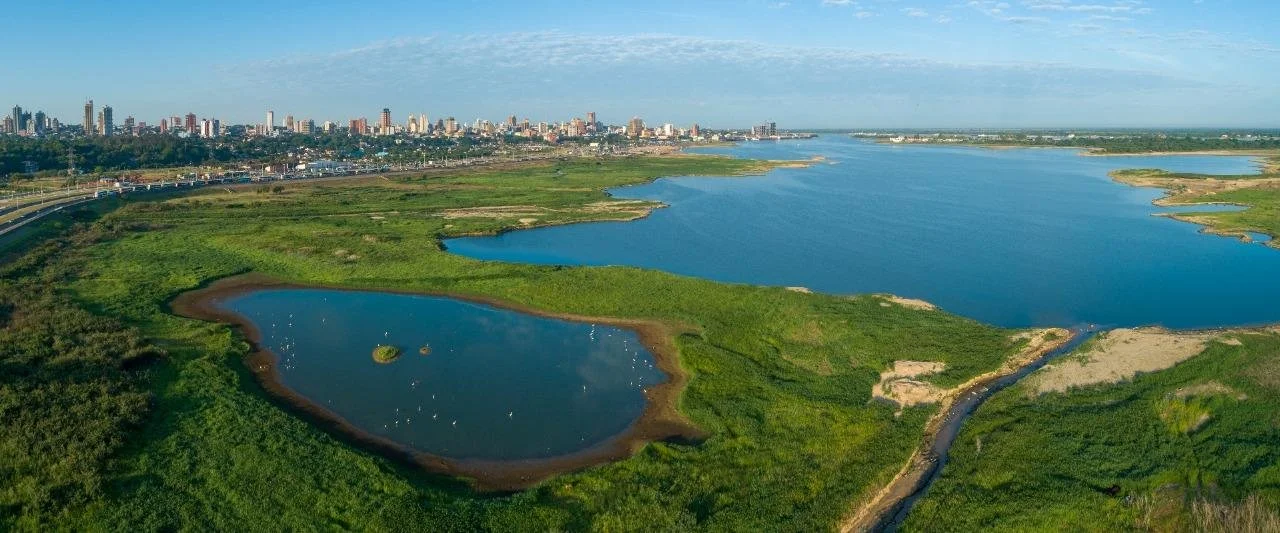Credit: This case study was kindly provided by the GEF and UNEP, as part of the GEF-6 programme.
Urban orchards in a natural reserve in Asunción, Paraguay
The Banco San Miguel y Bahía de Asunción ecological reserve is the city’s largest green area, and worldwide-interest bird reserve. However, poor waste management generates dumpsites and pollutes the reserve. To tackle this issue, the Municipality of Asunción, in partnership with the Asunción Green City project, set up four training workshops for women from local communities in San Miguel and Caacupemí. These women are heads of families and communities living inside the reserve. These training courses have the purpose to strengthen the capacities of communities to implement edible gardens and community agroecological orchards. Through four training workshops, women learned agroecological approaches, how to produce healthy food, incorporate crop diversification and native species, and how to segregate waste. Families who participated in the training received help to install agroecological orchards, participated in additional training on various topics related to orchards maintenance.
Key actors and partners
The Municipality of Asunción collaborated with the Asunción Green City to deliver the four training courses to the local communities. The trainings were given to women from the communities who are considered providers and educators in their families and communities.
project & Process overview
Member of the Banco San Miguel community with crops. Source: UNDP
“Banco San Miguel y Bahía de Asunción” Ecological Reserve is the city’s largest green area. Spreading over 300 hectares, this unique ecosystem is recognized worldwide as a conservation site for shore and migratory birds. However, the reserve is home to numerous families living in vulnerable conditions. Waste management has become a social and environmental challenge in the area, but the community is working with the Asunción Green City project to reduce irregular dumpsites and restore the reserve.
Edible gardens are small, designated spaces in a home or public space to grow a mix of ornamental and aromatic plants with vegetables and medicinal plants. Through the implementation of edible gardens, they can improve food security for families in the reserve, who can grow their own produce for self-consumption, with larger variety and better quality. Urban agroecological orchards are created in larger spaces and are generally meant for community use, ideally for legume crops and vegetable production such as beans, corn and yuca. These orchards introduce organic growing techniques that enrich and improve the soil.
The Banco San Miguel y Bahía de Asunción ecological reserve. Source: UNDP
The Municipality of Asunción worked with the communities of San Miguel and Caacupemí, inside the reserve, to offer four training workshops for women heads of households. The courses aimed at strengthening capabilities towards the implementation of edible gardens and community agroecological orchards. These initiatives seek to provide skills and improve opportunities for members of the community who have a key role in caring for the reserve and its ecosystems. Women are care providers and educators within their families and their community and can exercise an important leadership to contribute to the protection of the wetland system and the vast biodiversity that the Banco San Miguel Ecological Reserve protects.
« “Learning how to grow an edible garden is not something they teach in schools. Being able to pick up my own fresh produce just outside my kitchen window is healthier for my family and better for our economy. “ »
The training sessions followed an agroecological approach, aimed at the production of healthy food based on the principles of organic agriculture. Emphasizing the importance of protecting soil diversity and promoting crop diversification, the workshops also promoted the incorporation of native species, such as fruit trees, native medicinal plants and edible native ornamental species. The women also learned how to create vertical gardens, ideal for smaller spaces and had lessons on waste segregation, composting and techniques to upcycle different elements, such as bottles or tires, to create beds for plants.
Women in an orchards. Source: UNDP
results
« “With these techniques we can create our own orchards, grow our own organic vegetables. I have learned how to combine flowers with edible plants, how to enrich the soil, how to treat seeds and sprouts. And to top that, the garden smells amazing. “ »
An agroecological orchard was installed in each one of the communities that participated in the initiative, offering further training on composting, soil preparation and care with organic and natural products, planting in seedbeds and direct planting, selection of species according to the seasons, and a canned foods production workshop. Workshops were offered at the community's school. Following the success of the initiative, training sessions were scaled up to include other communities in Asunción's metropolitan area, who also live in the vicinity of large green areas.
lessons learnt
This case study demonstrates several aspects of an integrated approach to sustainable neighbourhood design.
The courses provided by the Municipality of Asunción were given to women as educators of their families and communities. By leveraging capacities of the women of the community, the project aims at empowering them, while giving them the responsibility to teach others. The project uses nature as a tool to foster inclusion, enhance food security and promote sustainable lifestyles. The creation of edible gardens was a way for the city to reduce waste production and promote food local consumption. Finally, it was also a way for the city to shed light on native species and preserve the cultural heritage of the region.
For more information on the project, please read about this case study here, and visit GEF website.




